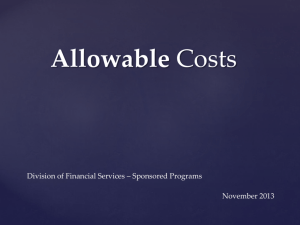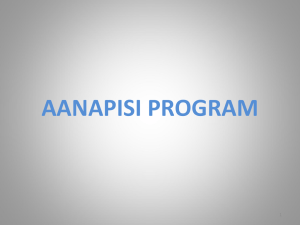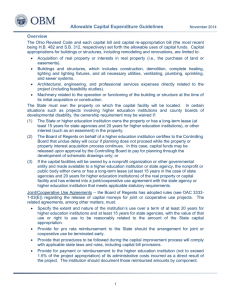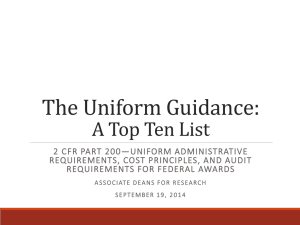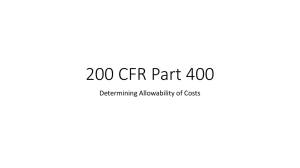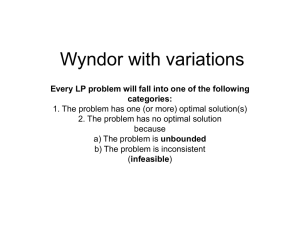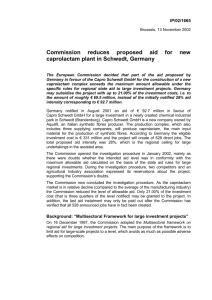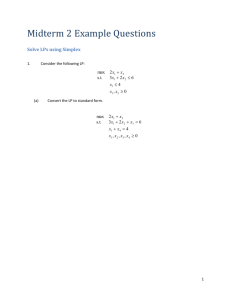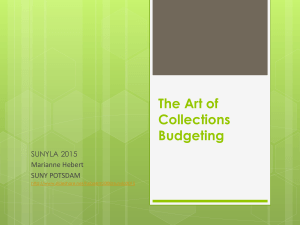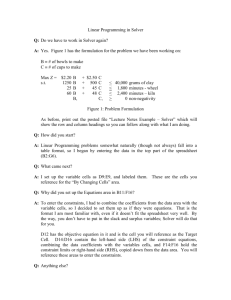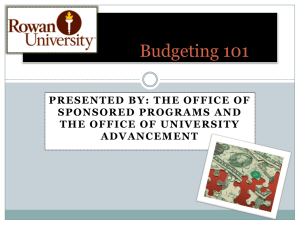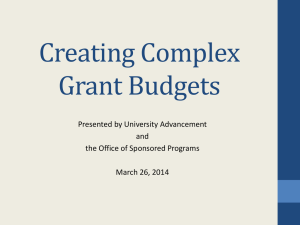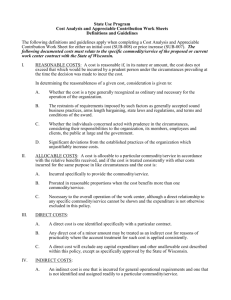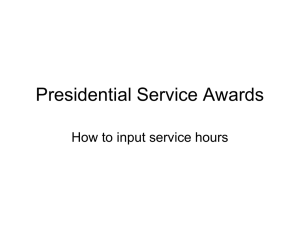What do you mean * I can*t charge food to my federal grant?
advertisement
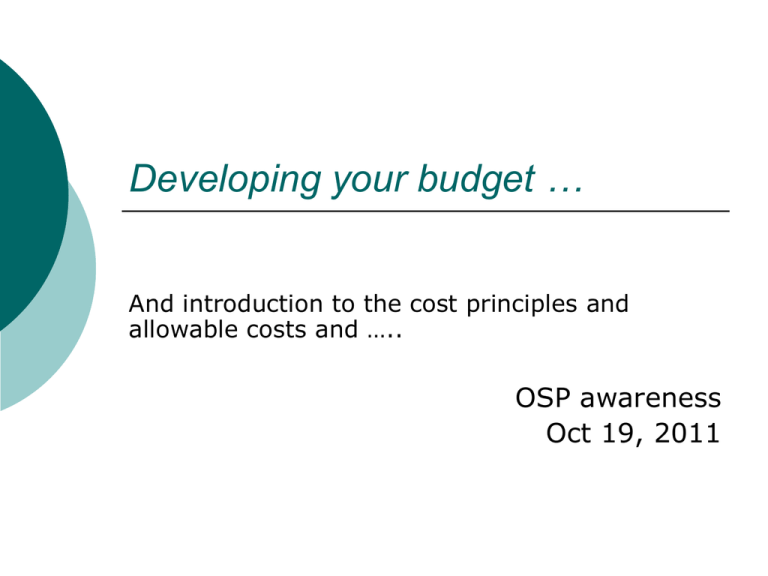
Developing your budget … And introduction to the cost principles and allowable costs and ….. OSP awareness Oct 19, 2011 What is a budget? Financial expression of your work plan (aka statement of work) Personnel costs Other than personnel costs Best estimate of financial resources needed to accomplish project Accurate Personnel Costs (a direct cost) SU folks whose effort will allow project objectives to be realized Key or senior personnel Folks responsible for project – ordinarily faculty Others Technicians Project managers Postdocs, grad students, undergraduates Admin/clerical Personnel Costs Salaries and wages How much? Proportion time allocated to grant Full time, half time, 25%; 1 sum month Fringe benefits Federally negotiated rates Annually updated Five employee classifications Reg staff/AY faculty; summer faculty; Grad Res Asst; PT/ES/OL; Adjunct Other than Personnel Costs Everything else… Travel Equipment (>$5,000) Materials & Supplies Non-SU people Collaborators/consortia, consultants Participants Tuition Publications ……… What about that ‘tax’ SU charges Also called “indirect costs” Or Facilities & Administrative costs Negotiated with federal government Research – on campus (47% FY 12), (48% FY 13) Instruction – on campus (32%) Other – on campus (33%) Off-campus Research, Instruction and Other (26%) Percent of what? Modified total direct costs Direct costs – tuition, equipment, subcontract > 25k, rent Estimating direct costs Check out osp.syr.edu http://osp.syr.edu/budgetdevelopment/Conceptualizing%20your%20Budget/Per sonnel.html Talk to those with more experience? What can you get done for the money? What do sponsor’s expect when budgeting and expending money…. Cost principles Cost Principles (Standards) Premise: Project costs = Allowable direct costs allowable indirect costs (IDC (or F&A)) Guiding Principles – Costs must be: Allowable, Allocable, Reasonable, and Consistently treated (DC) + What’s allowable? Must be reasonable (!); Allocable to sponsored agreements; Consistently treated; and Conform sponsored agreement. Sponsored agreement trumps all principles – no means no. What’s Reasonable? When you bought the item at price X and quantity Y You acted prudently – others would have made similar decision given facts and circumstances at the time. necessary; followed good business practices and applicable laws and regulations, and sponsored agreement terms and conditions; acted prudently given the circumstances; and, followed institutional policies If purchase posted on public blog, or NYS Times etc etc – how would folks react? What’s allocable? Item can be assigned (allocated) to an award/project, or function In proportion to benefit received Direct costs – exclusive benefit to project or can be reasonably assigned to multiple projects Indirect costs – benefit many projects or activities, can’t be reasonably assigned What’s Consistency? All costs incurred for the same purpose in like circumstances are treated the same If in F&A pool, there it stays, UNLESS cost is not for same purpose… If allocate to one award, ordinarily can’t shift to another award If charge to one award, can’t shift to another cause there’s $$ in the pot. Basically … Allowable as Direct Cost… Essential to support project Cost to sponsor in proportion to benefit received They pay the whole cost, they are the sole beneficiary University and sponsor allow Allowable in F&A (not DC) Needed to support many projects Not reasonable to assign proportion of benefit, including but not limited to Sect’y/clerical (cost of doing business) Lap top computers (general purpose equipment) Office supplies (cost of doing business) Local phone calls (cost of doing business) These are all administrative costs… (the “A” in F&A (“F” = facilities) Federal government’s concern Bear its fair share of sponsored project costs Protect public’s interests ($$) Protect public’s trust Areas where folks stumble (post award) Allocability Yale 7.6M: “Spending down” awards (cost transfers); deferred effort (did not work during summer) Consistency Charging admin personnel and ‘stuff’ Duke 1.6M And stuff like: Food…. That’s entertainment!! (j.17) Unless conference or meeting (j.32) PURPOSE – disseminate sponsor’s results (Remember: How does expenditure allow you to achieve project’s objectives?) Characteristics of meeting: Formerly announced; Agenda; List of attendees; Minutes, Proceedings etc. Or stuff like travel Go to <city> for conference Rent car to travel to <city> Stay extra time Can’t charge ‘extra time’ to grant Lexus with all bells and whistles Return Gas receipt time stamped after car returned Lack itemized receipts for procard transactions Core questions when developing budget AND spending $$.. How does purchase/expenditure (as DC) help accomplish the project’s objectives? Not allowed in solicitation / agreement? Is prior approval necessary? If cost in generally in F&A, how is situation non-routine, unlike? If yes, and not obtained, not allowed. Reasonable purchase? DOCUMENT in budget justification and when money $$ how purchase advances project’s objectives What do you think, #1? Sydney wants to buy a lap top using NSF grant dollars. Not in budget narrative Lap top will likely be in Sydney’s office Allowable cost? What do you think, #2? George has included secretarial support in his budget narrative for specific project activities. Project Awarded 25% of employee’s work load. George’s project is winding down and is now in the last year. The sec’ty quit at yr 4. George wants to charge 2% of senior administrator effort to grant. Allowable cost? What do you think, #3? Morgan wants to fly to Europe to disseminate his NSA project results. Tickets charged to NSA award, which requires prior approval before making the expenditure. Did not get prior approval Allowable cost? What do you think, #4? Helen has a grant to encourage increased representation of minority students in STEM fields. An important element is networking events, which involve …… food. Helen is not charging the cost of food to the sponsor, but wants to use the cost to meet mandatory cost-sharing. Allowable cost? What do you think, #5? Fred wants to buy a special freezer to store samples acquired during the award period. His department is running out of space and he has been asked to allocate ½ the freezer space to dept purposes. Allowable cost? What do you think, #6? Margie has weekly lab-group meetings to discuss progress on various sponsored projects. To encourage participation, she provides pizza and beer and wants to charge the costs to the grant. Allowable cost? Summary Follow the cost principles…AARC Justification, documentation of expenditures is essential & starts with budget narrative. Rarely black and white… many shades of grey.. Make compelling case why needed, why cost in proportion to benefit. Sponsors want to pay for their fair share Sponsors don’t want to pay for “cost of doing business unrelated to their business” But, sometimes, no means no…
